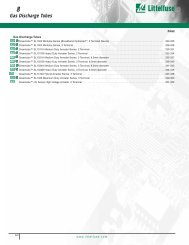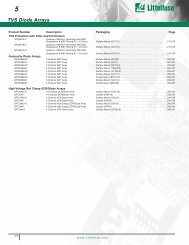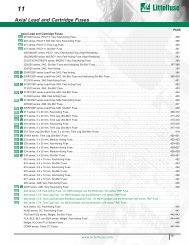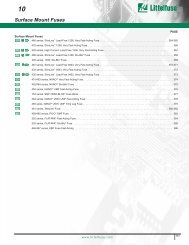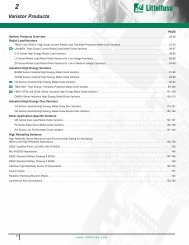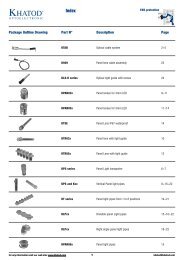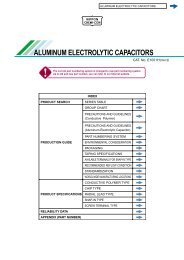Introduction to Circuit Protection
Introduction to Circuit Protection
Introduction to Circuit Protection
You also want an ePaper? Increase the reach of your titles
YUMPU automatically turns print PDFs into web optimized ePapers that Google loves.
<strong>Introduction</strong> <strong>to</strong> <strong>Circuit</strong> <strong>Protection</strong><br />
Fuseology<br />
Overcurrent Selection Guide Worksheet<br />
1. Define the circuit operating parameters (Complete the following form).<br />
Normal operating current in amperes:<br />
Normal operating voltage in volts:<br />
Maximum interrupt current:<br />
Ambient Temperature:<br />
Typical overload current:<br />
Required opening time at specified overload:<br />
Transient pulses expected (Quarterly)<br />
Resettable or one-time:<br />
Agency Approvals:<br />
Mounting type/form fac<strong>to</strong>r:<br />
Typical resistance (in circuit):<br />
2. Select the proper circuit protection component.<br />
3. Determine the opening time at fault.<br />
Consult the Time-Current (T-C)Curve <strong>to</strong> determine if the selected part will operate within the constraints of your application. If the device<br />
opens <strong>to</strong>o soon, the application may experience nuisance operation. If the device does not open soon enough, the overcurrent may damage<br />
downstream components.To determine the opening time for the chosen device, locate the overload current on the X-axis of the appropriate T-<br />
C Curve and follow its line up <strong>to</strong> its intersection with the curve.At this point read the time tested on the Y-axis.This is the average opening time<br />
for that device. If your overload current falls <strong>to</strong> the right of the curve the device will open. If the overload current is <strong>to</strong> the left of the curve, the<br />
device will not operate.<br />
4. Verify ambient operating parameters.<br />
Ensure that the application voltage is less than or equal <strong>to</strong> the device’s rated voltage and that the operating temperature limits are<br />
within those specified by the device.<br />
5. Verify the device’s dimensions.<br />
Using the information from the Designer’s Guide page, compare the maximum dimensions of the device <strong>to</strong> the space available in<br />
the application.<br />
6. Test the selected product in an actual application.<br />
Surface 30V PTC 60V PTC 0402 0603 1206 Nano2® Telelink PICO ® 0402,0603, 3.6 x10mm TR5 ® /TE5 ® Overcurrent Selection Guide:<br />
5x20 3AGs/<br />
Mount PTC Leaded Leaded SMF SMF SMF SMF Fuse II Fuse 1206 TFF Fuses 2AGs mm 3ABs Midgets<br />
Lead-Free Available<br />
Operating<br />
Current Range<br />
Maximum Voltage (*)<br />
Maximum Interupting<br />
Rating (**)<br />
Temperature Range<br />
Thermal Rerating<br />
Opening time at<br />
200% of Amp Rating<br />
Transient Withstand<br />
Resistance<br />
Agency Approvals<br />
Operational Uses<br />
Mounting/Form<br />
Fac<strong>to</strong>r<br />
(*) Maximum operating voltage in the series, parts may be used at voltages equal <strong>to</strong> or less than this value.<br />
(**) Maximum interrupting rating at specified voltage which may be less than maximum operating voltage.<br />
(***) Opening time is in relation <strong>to</strong> other forms of protection. A fast device will typically operate within three seconds at 200% of rated current.<br />
Pb Denotes Lead-Free Product according <strong>to</strong> Littlefuse standards. Contact fac<strong>to</strong>ry for availability.<br />
RoHS Denotes Lead-Free product according <strong>to</strong> RoHS specification. Contact fac<strong>to</strong>ry for availability.<br />
10<br />
RoHS<br />
0.200-<br />
2.6A<br />
15V<br />
40A<br />
Pb<br />
-40°C <strong>to</strong><br />
85°C<br />
High<br />
Slow<br />
Low<br />
Medium<br />
UL, CSA,<br />
TUV<br />
Multiple<br />
Surface<br />
Mount<br />
N/A<br />
0.900 -<br />
9A<br />
N/A<br />
0.100 -<br />
3.75A<br />
Pb RoHS<br />
0.250 -<br />
2A<br />
Pb RoHS<br />
0.250-<br />
5A<br />
Pb RoHS<br />
0.125 -<br />
7A<br />
RoHS<br />
0.062 -<br />
15A<br />
RoHS<br />
0.062 -<br />
15A<br />
Pb RoHS<br />
0.250-7A<br />
N/A<br />
0.100-<br />
10A<br />
Pb RoHS<br />
0.40 -<br />
10A<br />
Pb RoHS<br />
0.100 -<br />
10A<br />
Pb RoHS<br />
0.032-<br />
15A<br />
Pb RoHS<br />
0.010 -<br />
35A<br />
N/A<br />
0.100 -<br />
30A<br />
30V 60V 24V 32V 125V 250V 250V 24-125V 250V 125-250V 250V 250V 250V 600V<br />
40A 40A 35A 50A 50A 50A 50A 35-59A 35-63A 25-100A 10,000A 10,000A 10,000A 200,000A<br />
-40°C <strong>to</strong><br />
85°C<br />
-40°C <strong>to</strong><br />
85°C<br />
-55°C <strong>to</strong><br />
90°C<br />
-55°C <strong>to</strong><br />
90°C<br />
-55°C <strong>to</strong><br />
90°C<br />
-55°C <strong>to</strong><br />
125°C<br />
-55°C <strong>to</strong><br />
90°C<br />
-55°C <strong>to</strong><br />
125°C<br />
-55 <strong>to</strong><br />
+125°<br />
-40 <strong>to</strong><br />
85°C<br />
-55°C <strong>to</strong><br />
125°C<br />
-55°C <strong>to</strong><br />
125°C<br />
-55°C <strong>to</strong><br />
125°C<br />
-55°C <strong>to</strong><br />
125°C<br />
High High Medium Medium Medium Low Low Medium Low Low Low Low Low Low<br />
Slow<br />
Low<br />
Slow<br />
Low<br />
Fast<br />
Low<br />
Fast<br />
Low<br />
Fast <strong>to</strong><br />
Medium<br />
Low <strong>to</strong><br />
Medium<br />
Fast <strong>to</strong><br />
Medium<br />
Low <strong>to</strong><br />
Medium<br />
Fast <strong>to</strong><br />
Medium<br />
Low <strong>to</strong><br />
Medium<br />
Fast <strong>to</strong><br />
Medium<br />
Low <strong>to</strong><br />
Medium<br />
Fast <strong>to</strong><br />
Medium<br />
Low <strong>to</strong><br />
Medium<br />
Fast <strong>to</strong><br />
Slow<br />
Low <strong>to</strong><br />
Medium<br />
Fast <strong>to</strong><br />
Medium<br />
Low <strong>to</strong><br />
High<br />
Fast <strong>to</strong><br />
Slow<br />
Low <strong>to</strong><br />
High<br />
Fast <strong>to</strong><br />
Slow<br />
Low <strong>to</strong><br />
High<br />
Fast <strong>to</strong><br />
Slow<br />
Low <strong>to</strong><br />
High<br />
Medium Medium Low Low Low Low Low Low Low Low Low Low Low Low<br />
UL, CSA,<br />
TUV<br />
UL, CSA,<br />
TUV<br />
UL, CSA UL, CSA UL, CSA UMF, UL,<br />
CSA, MITI<br />
UL,<br />
CSA, MITI<br />
UL,CSA, UL,CSA,<br />
VDE, CCC<br />
UL,VDE<br />
Senko, METI,<br />
MITI, CCC, CSA<br />
CSA, BSI,<br />
UL,<br />
UL,<br />
VDE, MITI,<br />
CSA, MITI<br />
CSA, MITI<br />
SEMKO, UL<br />
UL,<br />
CSA<br />
Multiple Multiple One Time One Time One Time One Time One Time One Time One Time One Time One Time One Time One Time One Time<br />
Leaded Leaded<br />
Surface<br />
Mount<br />
Surface<br />
Mount<br />
Surface<br />
Mount<br />
Surface<br />
Mount<br />
Leaded<br />
Surface<br />
Mount<br />
Leaded Leaded<br />
Leaded or<br />
Cartridge<br />
Leaded or<br />
Cartridge<br />
Leaded or<br />
Cartridge Cartridge<br />
www.littelfuse.com




